
Crumb rubber concrete is a new type of concrete using crumb rubber as a composition of cement concrete materials. The purpose is to introduce a certain number of flexible components into the original multi-component concrete to improve the performance of the concrete. In this study, crumb rubber concrete specimens were prepared with different rubber contents (0%, 5%, 10% and 15%), and the following research was carried out. (1) Mechanical properties and crack monitoring for crumb rubber concrete based on acoustic emission (AE) technique and multiscale method. In this study, three-point and four-point bending test of crumb rubber concrete specimens were carried out. A microcracking monitoring and fracture evaluation method for crumb rubber concrete based on the acoustic emission technique was presented. The precursory micro-cracking activity and fracture behavior of crumb rubber concrete with different rubber content were analyzed. (2) Experimental study and refined numerical simulation on the static and fatigue behavior of crumb rubber concrete-steel composite beam. Crumb rubber concrete was first introduced into steel-concrete composite beams to replace traditional concrete slab. Experimental study and refined numerical simulation were used to investigate the static and the fatigue behavior of steel-concrete composite beam. The using of crumb rubber concrete improves the ductility and fatigue lives of stud shear connectors and steel-concrete composite beams.

CFRP material has many advantages such as light weight, high strength, corrosion resistance, small linear expansion coefficient. In order to promote the further development of long-span space structures, the space structures based on CFRP cables have gradually become the focus of research. This project focuses on the application of CFRP cable in spatial structure. According to the stress condition in CFRP cable in the spatial structure, a series of mechanical performance tests including the longitudinal tensile test, vertical compression test and lateral compression test, lateral shear test and three-point bending test were carried out. Based on this, a new type of anchorage joint for spatial structures was proposed, which provided key technical support for the engineering application of CFRP cables. In addition, the poor fire resistance due to the heat-sensitive of resin matrix limits the popularization and development of CFRP cable structures. Therefore, the high-temperature tensile test of CFRP tendon was carried out in the range of 20-600℃. The degradation relation of strength and modulus of CFRP tendon with temperature is obtained. It is proved that the model has good universality and provides a theoretical basis for the fire resistance design of CFRP cable-space structure in the future.

The Assembled Hub (AH) joints is a novel joint system used in spatial structures proposed by our research group, which have the advantages of simple construction, clear force transmission path and sufficient out-of-plane bending rigidity. The AH joint system is applicable to not only the traditional steel grids structures, but also prestressed latticed shells and aluminum latticed shells. In recent years, the load-transferring mechanism and the failure modes of the new joint system under axial force, bending moment, eccentric load and out-of-plane cyclic load were revealed by theoretical study, FEA and full-scale tests. The formulas of the initial stiffness and the beading capacities were derived based on the component method. The ring stiffener and the radial stiffener were proposed to raise the bearing capacities of AH joints. Meanwhile, the combined nonlinear spring model was established to simulate the mechanical behavior of AH joints in the stability analysis. The range of the reduction factors of the stability bearing capacity was determined based on the parametric analysis.
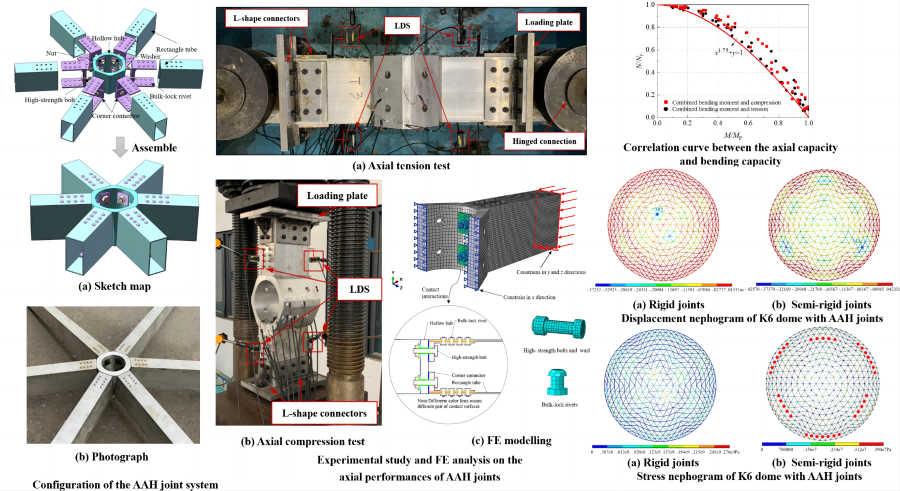
Fire performance of aluminium alloy structures was comprehensively investigated from three levels, including material, specimen and connection levels. Material level: we conducted steady- and transient-state tests to obtain key mechanical properties and stress strain curves of aluminium alloys in fire. The test results derived from these two methods were compared and a two-stage aluminium alloy constitutive model for aluminium alloys in fire were proposed. Specimen level: parametric analyses on aluminium alloy plates in fire were performed and the results were utilized to propose an improved design methods for local buckling of aluminium alloys in fire, which considers the more curved stress strain curves and changing mechanical properties of aluminium alloys in fire. The improved method was validated by test results obtained from 24 tests on aluminium alloy stub columns at room and elevated temperatures. Connection level: we conducted tests to obtain the mechanical properties of swage lock pins in fire and then tests on aluminium alloy shear connections connected by swage lock pins were also performed. Based on the test results, the current design methods for aluminium alloy shear connections in fire were modified.
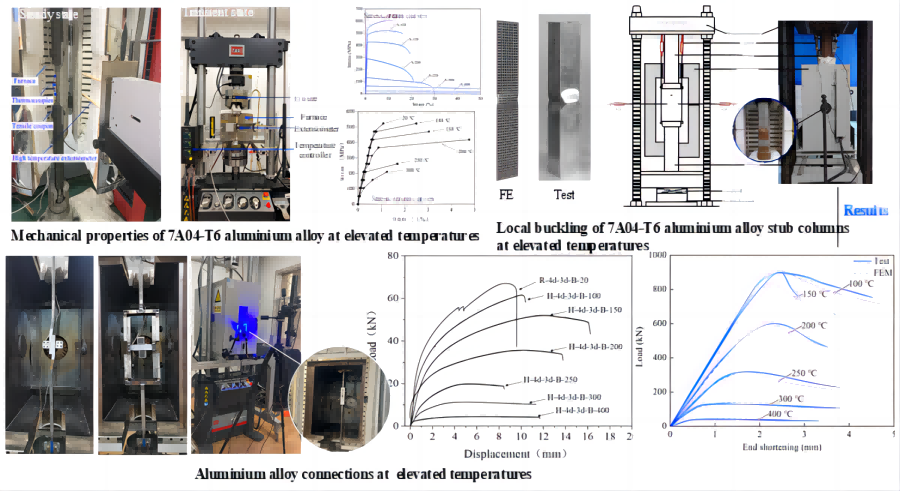
Fatigue failure of steel structures is one of the most important destructive forms in practical engineering situation, which has become a research focus of scholars. In our group, G20Mn5QT cast steel joints and the circular butt weld are used to study: (1) Fatigue tests are conducted to obtain the equations and parameters such as S-N curve, fracture toughness and fatigue strength, which provide data support for further research on the fatigue properties of base metal and weld; (2) Numerical simulation combined with fatigue data is used to analyze the influence of hot spot stress and residual welding stress on fatigue performance. The hot-spot stress S-N curves of various circular butt welds are proposed, and the fatigue life can be predicted; (3) The fatigue crack growth performance of base metal and the weld is systematically studied. Based on the Paris formula and by establishing a two-parameter crack driving force model, the fatigue crack growth rate equation is obtained. It can provide the constitutive equations for the fatigue design of base metal and weld; (4) The microstructure of the fracture is analyzed through using SEM, and the fatigue crack propagation mechanism is deeply understood; (5) The acoustic emission technique is introduced to monitor fatigue cracks, which can realize the identification, location, damage quantification and life prediction of fatigue cracks.

Low-cycle axial, torsional and multiaxial fatigue experiments under strain control are carried out for thin-walled tubular welded specimens. The modes of fatigue cracks are determined and the parameters of cyclic stress-strain relationship are obtained. Based on macro and micro mechanics, the multiaxial fatigue damage mechanism of welded material under different loading paths is revealed. The effect principal axis rotation of shear strain on the whole plane fatigue damage is considered under non-proportional loading paths, and the critical plane directions are weighted by introducing weighting function. Thus, a new multiaxial fatigue life prediction method with energy-based fatigue parameter is proposed for welded material. Based on structural stress method, the membrane and bending stress components at weld toe/heel along the plate thickness of tube-plate welded joint is calculated, and multiaxial fatigue life prediction method for welded joint is put forward.
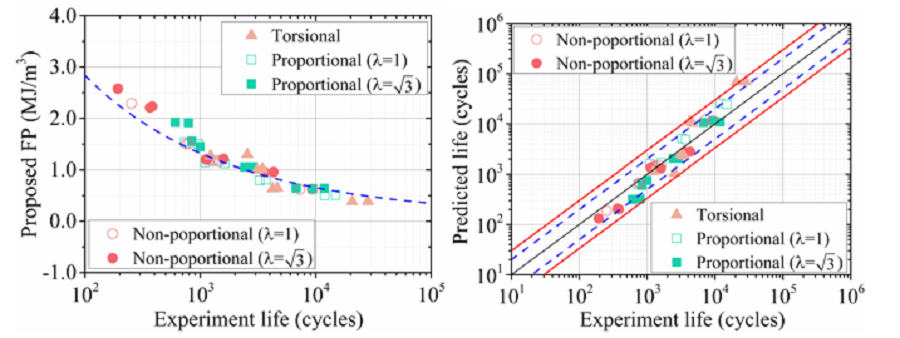
The corrosion tests of G20Mn5QT cast steel and butt weld with Q345D steel in wt3.5% NaCl solution are conducted. It is mainly corrosion pitting for G20Mn5QT cast steel due to the casting defect and the erosion of chloride ions. The corrosion morphology of weld zone and HAZ tends to be uniform corrosion accompanied with pitting corrosion. Welding defect and erosion of chloride ions cause pitting corrosion for weld zone and HAZ. Corrosion fatigue experiments are carried out on G20Mn5QT cast steel and butt welds with Q345D hot rolled steel in simulated seawater. The maximum cyclic stress vs. the number of cycles to failure (S-N) curves are fitted through the least squares method. Corrosion pitting is formed when the surface of the material is corroded by chloride ions. The stress concentrations caused by pitting lead to crack nucleation. In order to evaluate material corrosion fatigue life, the maximum cyclic stress vs. number of cycles to failure curve is modified based on the three-parameter Weibull distribution model. The fitting results are close and the form of the S-N curves is similar. The fitting precision of S-N curve is higher, and the curve has a better bending shape based on three-parameter Weibull distribution model compared with that by the recommended Basquin model or Stromeyer model. It is helpful to evaluate the corrosion fatigue life.
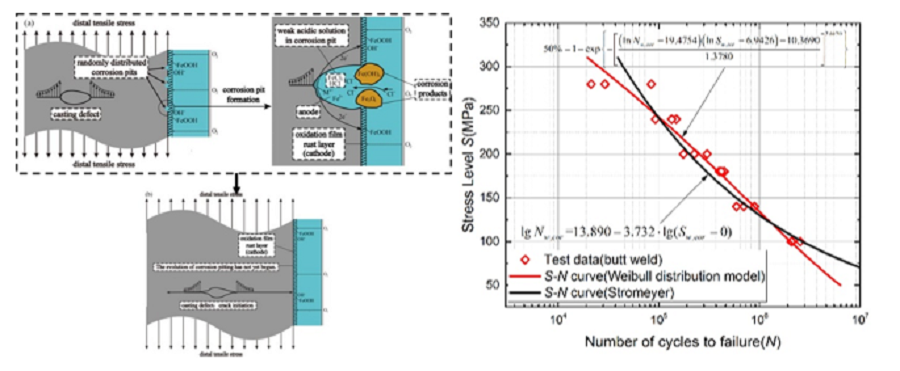
The large-span spatial structure has the characteristics of significant vertical vibration, remarkable spatiality, and complex dynamic characteristics. There is still a lack of the research on seismic isolation and vibration control technology and the mechanism of intelligent control. Based on the former, the three-dimensional isolation bearing and high-performance vibration control damper for the large-span spatial structure has been designed. The theoretical models of three-dimensional isolation bearing and vibration control high-performance damper have been established and calculated. The new three-dimensional seismic isolation and high-performance vibration control systems of the large-span spatial structure have been preliminary built. To establish the theories and methods of structural intelligence control, it is planned to further study the damage mechanism and collapse mechanism of large-span spatial structures under strong earthquakes or strong wind/typhoons. The research contents include: (1) Mechanical properties of the new three-dimensional isolation bearing and the new multi-dimensional seismic isolation system of the large-span spatial structure; (2) Mechanical properties of high-performance vibration control damper and the new multi-dimensional vibration control system of the large-span spatial structure; (3) Failure modes and intelligent control methods for the multi-dimensional seismic isolation and vibration control system of the large-span spatial structure; (4) Seismic failure mechanism and seismic performance design method for the new multi-dimensional seismic isolation system of the large-span spatial structure.
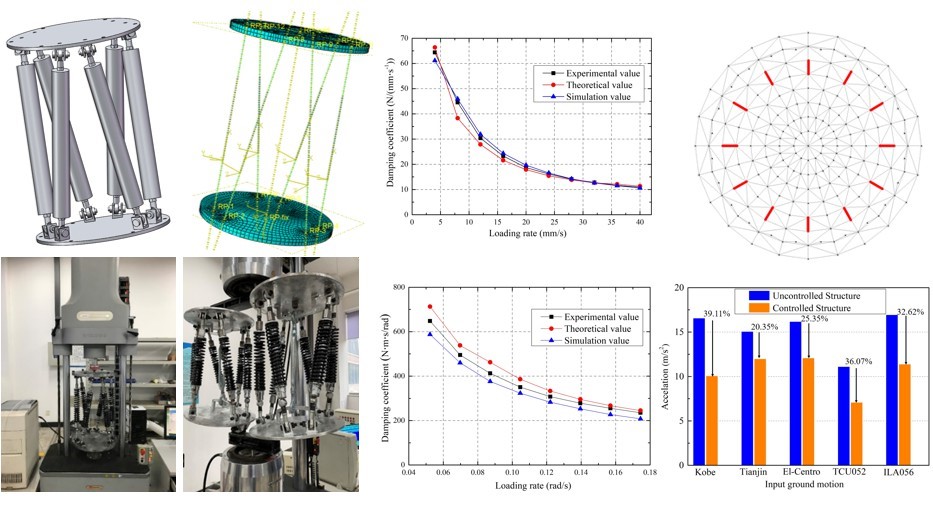
The principle of reducing the degree of freedom of substructure is determined by the number of modes required when the mass coefficient of cumulative mode participation of substructure reaches 90%, the seismic response analysis of the large-span spatial structures and the non-structural components based on dynamic substructure method is carried out. The computational efficiency is increased by 3 times. Based on the shaking table test, the effects of the upper structures on the vertical seismic response of the suspended ceiling system are clarified, and the failure modes of the suspended ceiling system, such as the falling of ceiling panels, buckling of runners, and failure of joints, are revealed. The recommended acceleration amplification coefficient of flexible supporting structure is obtained. Then, taking spatial structures as numerical substructure and point-supported glass curtain wall as test substructure, the pseudo-dynamic test of point-supported glass curtain wall is established, and its seismic response and failure mode are obtained. Based on the horizontal displacement angle of the curtain wall and the failure area of the glass panel, the performance level of the point-supported glass curtain wall is established, and the seismic vulnerability curve of the point-supported glass curtain wall is also obtained based on the incremental dynamic method, which provides a theoretical basis for the seismic design of non-structural components of large-span spatial structures.
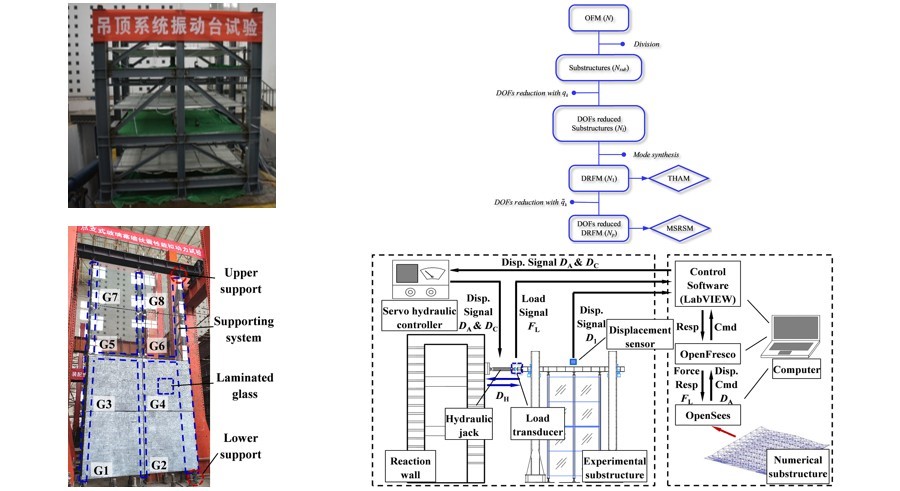
Investigations were performed on monopile offshore wind turbines and bridge piers under combined wave-current and earthquake action to obtain proper similitude law for the design of scale models. For monopile offshore wind turbines, simulation platform for calculating the aerodynamic forces acted on structures were established based on Simulink in MATLAB, which solves the contradictions between the Froude and Reynolds similarity criterion. With regards to bridge piers, numerical wave tank and numerical wave-current tank were established based on Ansys Fluent. The mesh and time step sensitivity were analyzed, and optimized parameters were derived for the numerical tank. Based on the numerical tank, interactions between structures and wave-current were simulated and the numerical results were validated by test results in terms of water elevations and horizontal forces.

The large-span space structure has a large volume, many nodes, dense natural frequency distribution, complex vibration shapes, and monitoring data is greatly affected by environmental factors such as temperature. The current health monitoring methods have limited applicability in large-span space structures. Based on this, this research group uses advanced hardware technologies, combined with the latest signal processing technology, statistical theory and machine learning methods, and have carried out a series of researches on intelligent monitoring methods. The main tasks include (1) Application of acoustic emission technology in structural health monitoring and research on data processing technology. Apply pattern recognition algorithms such as clustering information and Bayesian method to carry out specific research on damage recognition methods based on acoustic emission data; (2) Research on intelligent monitoring method for structural damage diagnosis based on vision. Use image acquisition equipment such as UAV, smartphones, and high-definition surveillance cameras to collect damage images from the structure, and use deep learning algorithms to diagnose visible damage of the structure; (3) Research on structural parameter identification and damage monitoring methods in a time-varying environment. Considering the impact of environmental variability conditions such as temperature on the analysis of health monitoring data, use the latest signal processing and statistical theory to analyze the overall vibration response of the structure measured from the health monitoring site and the static response data of local key components, and identify structural damage and perform a safety status assessment.
